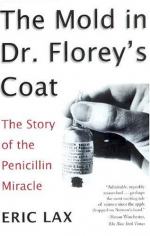|
This section contains 540 words (approx. 2 pages at 300 words per page) |

|
Penicillin
Summary: Although penicillin was discovered in 1928, scientists did not begin to discover its many benefits until over a decade later. Ordered in mass quantities by the U.S. government as it entered World War II, penicillin was found to be an effective antibiotic for scarlet fever, syphilis, gonorrhea, diphtheria, rheumatic fever, and other diseases.
In 1928, in his search for an antibacterial agent, Alexander Fleming accidentally stumbled upon a certain mold that would later become a "wonder drug." Fleming noticed that a fungal colony of mold had contaminated an agar plate smeared with the bacterium Staphylococcus aureus (Deacon). In the area surrounding the mold, the cocci had disappeared. Since he had devoted his career to finding methods for treating infections, he continued to study this occurrence. He found that this fungus was actually Penicillium notatum, which he named Penicillin. In later studies, he found that penicillin could prevent the viruses of streptococci and pneumococci, and most gram positive bacteria. In order to find if this agent was poisonous to humans, he tested it on a rabbit infected with the staphylococcus virus. The penicillin halted and lessened the virus but unfortunately, Fleming didn't have enough to fully cure the rabbit. Fleming slowly grew more...
|
This section contains 540 words (approx. 2 pages at 300 words per page) |

|


